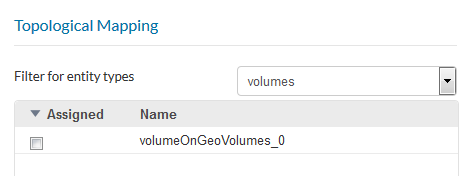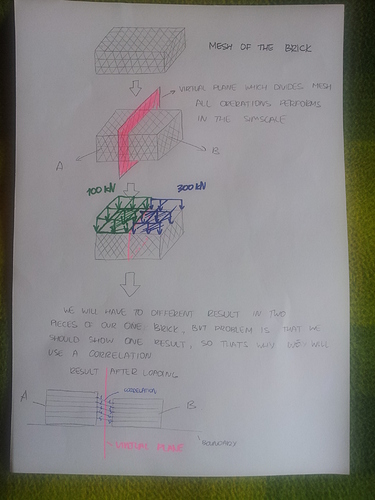Hello! I am not a specialist in Mechanical Engineering but I have some recommendations. Could you please indicate in Post-Processing the units of measurements in the final results
for Example: Displacements [mm or cm or m] with possibility of choosing
Stress [Pa or kPa or MPa] also in VonMises Stress.
It will be better if we have a possibility to divide single surface into several necessary areas directly in browser and distribute different forces to the same surface in different areas.
@berish: Thanks for your suggestions (I moved them to the “Product Feedback” category)! Very valid points!
I added you to the feature request of the “Units within the post-processor”. That’s already on our roadmap and will be available with one of the next releases.
Regarding your second point: I had discussions about such a feature internally and also with customers, but did not yet reach a final conclusion on it. Isn’t it more convenient to do such operations within the CAD system before uploading it to simulate it? As most CAD systems also provide a sketch functionality etc. it provides more freedom to perform such operations. Would you say it makes more sense for your workflow to do this within SimScale? Or would you want to do such an operation on the mesh itself? Thanks for your feedback!
About the second point. It will be more convenient to do it in such operation on the mesh as an additional or optional operation. User will have two choiсes: to do it in CAD or in the SimScale. I think it will be a big advantage.
Kind regards!
@berish: Agreed - providing more simulation specific CAD preparation or mesh manipulation capabilities might be valuable to a lot of users. What about splitting edges? Would then make sense for loads or constraints on edges as well, right?
Hi.
- Yes, yes, yes! Dimensions in pre-processor are very good idea - definitely.
- I understand ‘berish’ point of view, but I’m afraid it may be difficult to implement. I mean you would have to introduce basic CAD to SS and it’s like adding a separate program. Therefore I have different idea: maybe you would be able to introduce body-body load transfer? In static structural. The same way it works in dynamic simulations.
- Now my suggestion - this time for CFD pre: wouldn’t it be better idea to put all the initial conditions into one window (velocity, pressure, temperature)? What’s more, in the same window, to add fluid settings such as density, temperature, coefficients… I know it’s mostly air or water but still. In longer term equations for basic, initial estimation of k, epsilon or omega could be linked to it. Or, for instance, temperature defined by user would automatically set the density. Let me know what do think?
If you will do a function of manual indicating areas by choosing shape and dimensions directly on the surfaces. It will perform by buttons of the mouse. Splitting edges I think it is possible to perform, for example we will split one area, it is better if I will show it
- Got it - another +1 for units in the PP

- Agreed on the additional CAD functionality - possible, but to make this really good it definitely needs some thought. Not sure if I got your concept of the body-body load transfer - could you elaborate. To solve @berish’s assignment of different loads to different ‘regions’ of a face, I would split this specific face in my CAD tool and upload it. Isn’t this the easiest way - at least right now?
- Very valid point! We are right now looking into providing a more streamlined way of specifying fluid properties as well as the initial conditions. Would be up for some beta testing once we have something to show?
I like this idea on splitting mesh concept for assigning of loads. Splitting the face in CAD tool is easy and i believe that’s the practice widely used now. But doesn’t it consume a lot of time on meshing the process again ? but with this concept of splitting the mesh , i think it can save a lot of time if a person needs to apply an additional load condition in the future.
Great ideas here!
- I agree with Berish on the need of indicate the units in Post-Processing. It clearly facilitates our job.
- With this topic I’m not sure if it’s a good idea…I understand Dheiny point of view, I think it’s easier to do it on CAD system. Although it is true that this kind of things improve Simscale utilities, so I think it’s something to implement but maybe it’s not very urgent.
- Finally I also think that it is important to simplify the way to introduce initial conditions as Maciek says.
Thanks for joining the discussion! Another +1 for the Units in PP. Regarding 2. - I agree very much. But I put it on the internal agenda to discuss a potential feature in this direction - I’ll keep you updated, but it might not be very soon. @EnriqueKeelWit - I would ping you once we are doing beta testing for this feature, if you like.
Best,
David
What I mean by body-body load transfer:
Well, normally objects (particular parts of geometry in assembly) don’t “see” each other. You have to point regions where objects meet/interact. For instance let’s take two boxes and name them A and B. We put them on the ground so they stay next one another. They are separate geometries and there is no contact between them. Now, Box_A is fixed to the ground. Box_B however is being pushed from one side in the Box_A direction. If there is no contact defined Box_A will be “invisible” to Box_B therefore Box_B will go through Box_A. What I’d like to have (as a feature/function) is automatic clash (conflict) detection between those two boxes - as you have in computer games’ engines.
It is also present in CAD systems and used to identifying errors in assemblies.
Theoretically you already have this function or it will be available soon in crash test cases. This is very good example of what I’m writing about. You don’t define contact regions between objects and they still interact. And it works.
I’m aware this approach is more demanding numerically than just standard static FEA, but I think it could be used many times improving accuracy - in large deformation cases for instance, where due to big displacements additional contacts may occur.
Moreover, if you mastered it this solution is ready for CFD with overlapping meshes!
I know such approach makes simulations available for people with very little knowledge and experience, but on the other hand professionals would welcome it heartily. It would make their work easer and allow them to perform more advanced simulations with smaller margin of error due to less model simplifications.
I hope you get the point :-)
I don’t think so. In my opinion, if we work with complex initial conditions, where all velocities, pressure and so on are functions, we will go crazy in one window😶
It will be great if we have hybrid initialization, such it is in Ansys Fluent, because it will help to avoid some iterations and make calculation faster.
With regards to split faces.
This is how my work flow often goes. Create a model, upload to SS, mesh, apply loads, apply constraints, apply contacts… Doh! I forgot to create a surface region in my CAD file.
While it would be handy if SS provided the functionality to split faces I do not see this as SS scope of supply.
What I would rather see is an improved ability to handle geometric changes.
In the majority of cases, my geometric changes between simulations are small because I’m usually trying to understand the effect of one change at a time. This means that most geometric changes result in a lot of repetition - connecting the same definitions to the same topological entities.
If the underlying geometry of a simulation is changed then this is what I would like to see:
- Attempt to reconnect all topological entities if the new geometry contains matching entities. By matching I mean they pass some basic checks like same position and same size. I’d rather see most of my geometry reconnected with the odd mistake than have to redefine everything.
- If a topological entity cannot be replaced then the default type (volume, surface, edge, node) should be set to whatever it was previously.
This would make all geometry changes (not just split faces) much quicker.
that makes a lot of sense! Keeping the associativity between mesh/simulation setup and the (possibly changing) CAD model is something asked for a lot by users and we are actively working on it. This probably would address the first point you mentioned. But I am not sure if I understood your second point correctly - what exactly do you mean by default type? Could you elaborate?
Thanks,
David
When the geometry in a simulation is changed the topological mapping filter switches back to “volumes” regardless of what the previous type was (face, edge node etc). It would be nice if the previous type was remembered so that the only thing the user is required to do is select the appropriate entities from the model viewer and “Add selection from viewer”.

The selection type in the model viewer should also be set to match the previous type.
![]()
Regards, Ben
@BenLewis, now I got it! That also makes a lot of sense. Added this suggestion to the feature request. Will keep you posted on its development!

